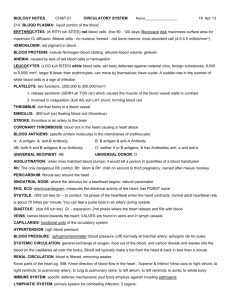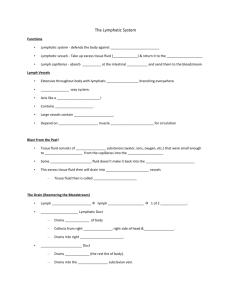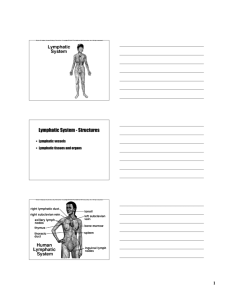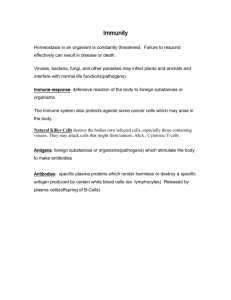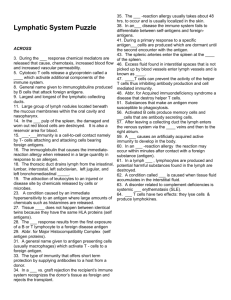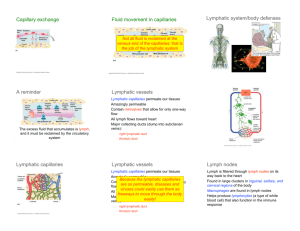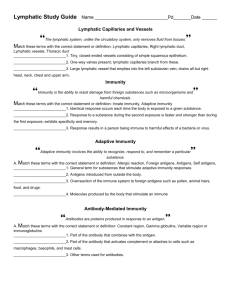Chapter 19&20: The Lymphatic System and Immune
advertisement
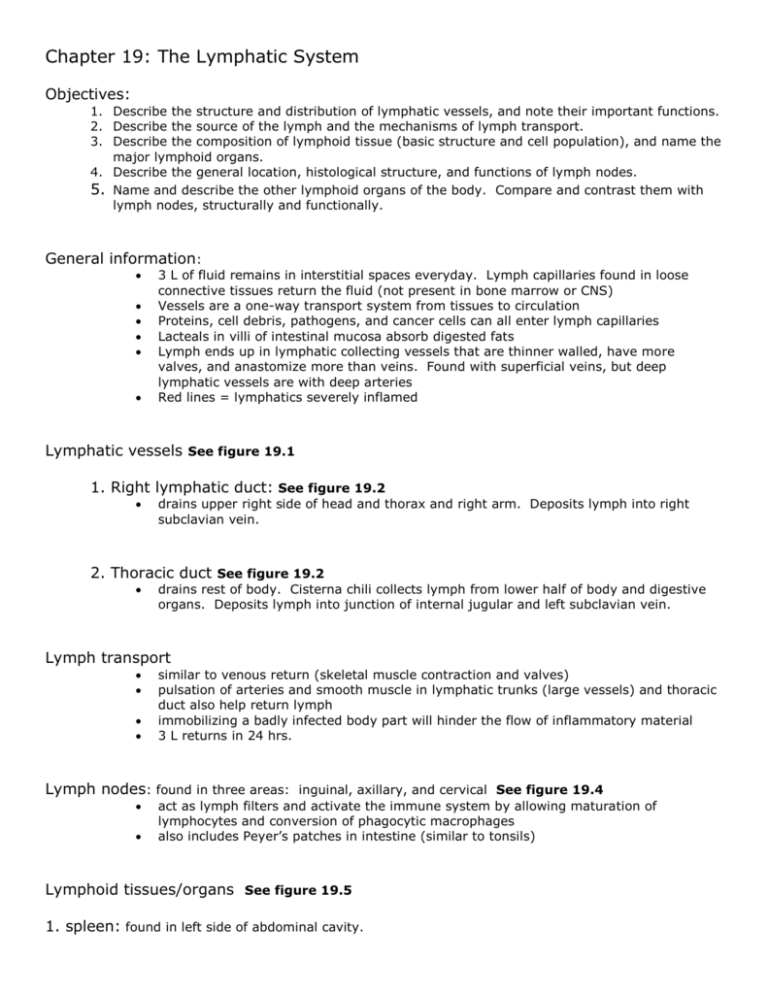
Chapter 19: The Lymphatic System Objectives: 1. Describe the structure and distribution of lymphatic vessels, and note their important functions. 2. Describe the source of the lymph and the mechanisms of lymph transport. 3. Describe the composition of lymphoid tissue (basic structure and cell population), and name the major lymphoid organs. 4. Describe the general location, histological structure, and functions of lymph nodes. 5. Name and describe the other lymphoid organs of the body. Compare and contrast them with lymph nodes, structurally and functionally. General information: 3 L of fluid remains in interstitial spaces everyday. Lymph capillaries found in loose connective tissues return the fluid (not present in bone marrow or CNS) Vessels are a one-way transport system from tissues to circulation Proteins, cell debris, pathogens, and cancer cells can all enter lymph capillaries Lacteals in villi of intestinal mucosa absorb digested fats Lymph ends up in lymphatic collecting vessels that are thinner walled, have more valves, and anastomize more than veins. Found with superficial veins, but deep lymphatic vessels are with deep arteries Red lines = lymphatics severely inflamed Lymphatic vessels See figure 19.1 1. Right lymphatic duct: See figure 19.2 drains upper right side of head and thorax and right arm. Deposits lymph into right subclavian vein. 2. Thoracic duct See figure 19.2 drains rest of body. Cisterna chili collects lymph from lower half of body and digestive organs. Deposits lymph into junction of internal jugular and left subclavian vein. Lymph transport similar to venous return (skeletal muscle contraction and valves) pulsation of arteries and smooth muscle in lymphatic trunks (large vessels) and thoracic duct also help return lymph immobilizing a badly infected body part will hinder the flow of inflammatory material 3 L returns in 24 hrs. Lymph nodes: found in three areas: inguinal, axillary, and cervical See figure 19.4 act as lymph filters and activate the immune system by allowing maturation of lymphocytes and conversion of phagocytic macrophages also includes Peyer’s patches in intestine (similar to tonsils) Lymphoid tissues/organs See figure 19.5 1. spleen: found in left side of abdominal cavity. Site of lymphocyte (B cell) proliferation, immune surveillance and response Extracts aged and defective blood cells and platelets, debris, foreign matter, bacteria, viruses, toxins Stores recyclable products from blood (iron) RBC production in fetus Stores platelets 2. thymus: found in mediastinum, site of T cell maturation 3. tonsils: trap bacteria, particulate matter Pharyngeal (adenoids) Palatine Lingual Chapter 20: The Immune System: Innate and Adaptive Body Defenses. Objectives: 1. Describe the surface membrane barriers and their protective functions. 2. Explain the importance of phagocytosis and natural killer cells in nonspecific body defense. 3. Describe the inflammatory process. Identify several inflammatory chemicals and indicate their specific roles. 4. Name the body’s antimicrobial substances and describe their function. 5. Explain how fever helps protect the body. 6. Define antigen and describe how antigens affect the immune system. 7. Compare and contrast the origin, maturation process, and general function of B and T lymphocytes. 8. Describe the role of macrophages and other phagocytes. 9. Define immunocompetence and self-tolerance. 10. Define humoral immunity. 11. Recount the roles of plasma cells and memory cells in humoral immunity. 12. Compare and contrast active and passive humoral immunity. 13. Explain the functions of antibodies. 14. Define cell-mediated immunity and describe the process of activation and clonal selection of T cells. 15. Describe T cell functions in the body. Nonspecific Defenses: do not react to nor target specific antigens, just antigens in general. See figure 20.1; Table 20.2 1. First line of defense: skin and mucous membranes Keratin provides a physical barrier to bacteria, weak acids and bases, bacterial toxins and enzymes Acidity of skin (pH 3-5) inhibits some bacterial growth and sebum has chemicals toxic to bacteria, vaginal secretions are also acidic Stomach secretes HCl and protein digesting enzymes Saliva and lacrimal fluid (tears) contain lysozyme, a chemical that destroys certain bacteria Mucus traps organisms and cilia sweep them away Genetic lack of receptors or inadequate supply of nutrients 2. Second line of defense Phagocytes (monocytes become macrophages) See figure 20.2 Neutrophils – most abundant types of WBC, eosinophils and mast cells Phagocytes must adhere to invader, but complement and antibodies allow opsonization to make eating easier NK cells police blood and lymph; lyse and kill cancer cells and virus infected cells. Release perforins Second line of defense (continued) A. Inflammatory response: triggered when body tissue injury occurs See figure 20.3; Table 20.1 i. purpose Prevents spread of infection/microbes Disposes of debris and pathogens Repair process is enhanced ii. signs: redness, swelling, heat, pain (sometimes impairment of function) iii. chemicals released Histamine: vasodilation and increased permeability of capillaries Kinins: similar to histamine, chemotaxis, pain Complement: lyses microbes, enhances phagocytosis, intensifies inflammatory and immune responses iv. hyperemia: increased blood flow Congestion of tissues w/ blood causes heat and redness exudates causes swelling and pain v. edema Helps dilute harmful substances that may be present, brings oxygen and nutrients in for repair and allows clotting proteins to isolate injured area Phagocyte mobilization See figure 20.4 1. leukocytosis: chemicals from injured cells promote release of neutrophils from bone marrow (characteristic sign of inflammation) 2. margination: blood flow slows in capillaries, cell adhesion molecules (CAMs) cause neutrophils to cling to area of inflammation 3. diapedesis: neutrophils move out of blood stream and into tissues by squeezing through capillary walls 4. chemotaxis: neutrophils respond to chemical signals that act as homing devices or beacons, directing cells to site of injury. Monocytes come later and mature into macrophages to clean up area 5. pus: a mixture of dead or dying neutrophils, broken down tissue cells and living and dead pathogens Other nonspecific defenses 1.interferon: a protein made from virus infected cells. Interferes with viral replication in neighboring cells by blocking protein synthesis at the ribosomes. Also activates macrophages and mobilizes NK cells. See figure 20.5 2. complement: 20 plasma proteins that, when activated, amplify all aspects of the inflammatory response as well as killing bacteria by attacking their cell membranes and causing lysis, or contributing to opsonization for phagocytosis. See figure 20.6 3. fever: pyrogens (fever causing chemicals) are released by leukocytes. Heat inactivates bacterial enzymes, keeps iron and zinc needed for cellular function away from bacteria, and speeds up repair of body cells Specific immunity: adaptive defenses or 3rd line of defense See figure 20.8, Table 20.4, figure 20.20 1. It is antigen specific: recognizes and is directed against particular antigens. 2. It is systemic: not restricted to the initial infection site. 3. It has memory: a stronger and quicker second attack is mounted on previously encountered pathogens. See figure 20.11 Humoral or antibody-mediated immunity See figure 20.10 B lymphocytes, which mature in the bone marrow and proliferate in the lymph nodes and spleen, are activated when antigens bind to their surface receptors (BCR’s). The B cell with the receptor for a specific antigen will then grow and rapidly divide, producing a family of cells with the exact same antigen-specific surface receptors called a CLONE. Most cells of the clone become plasma cells, which secrete antibodies with the same specificity as the BCR on the parent cell. Clone cells that do not differentiate into plasma cells become long-lived memory cells that are involved in the secondary immune response. Antibodies are Y-shaped molecules made of 4 polypeptide chains: two heavy and two light, bound by disulfide bonds. Each heavy and light consist of a variable region (the arms or Fab) and a constant region (the bottom or Fc). The Fab region of an antibody binds to a specific antigen. See figure 20.13 Antibody-antigen complexes are formed that cause: See figure 20.14 o Neutralization or masking of exotoxins and viruses o Agglutination of particulate or cellular material o Precipitation of soluble antigen o Fixing and activation of complement o Opsonization Antibodies come in 5 classes: See Table 20.3 o IgG: which is the most abundant circulating Ab, can cross the placenta, activates complement, protects against bacteria, viruses and toxins o IgM: binds to B cells as a receptor, forms a five antibody molecule that is first released by plasma cells during an infection. Causes agglutination reactions in mismatched blood types, and activates complement o IgA: found in body secretions (sweat, saliva, tears) as a two antibody molecule and helps prevent attachment of pathogens to mucous membranes and epidermis o IgE: secreted by skin, mucosa, and tonsils. Constant (Fc) region binds to mast cells and basophils and when bound to antigen on the variable (Fab) region, it causes the o cells to release histamine and other inflammatory chemicals. Levels rise during allergies. IgD: binds with IgM to B cells as a receptor Active and Passive Humoral immunity See figure 20.12 1. Naturally acquired active immunity: individual encounters antigen through normal means and produces its own antibodies against it (catch a cold and get better) 2. Naturally acquired passive immunity: individual receives antibodies from another person through normal means (antibodies cross the placenta) 3. Artificially acquired active immunity: individual is injected with antigen that does not cause disease (vaccinations/immunizations) 4. Artificially acquired passive immunity: individual is injected with antibodies produced by another person or organism (gamma globulin shots) Cell Mediated Immunity See figure 20.15 T cells learn self from nonself antigens while developing in the thymus See figure 20.9; 20.17 T helper cells (CD4+), once primed by APC’s (antigen presenting cells) stimulate proliferation of cytotoxic T cells (CD8+) and B cells. Without CD4+ cells to direct it, there is no immune response. Their cytokines (chemical mediators) supply the help needed to do the recruiting of other immune cells. See figure 20.18 Cytotoxic T cells (CD8+) kill virus infected cells, cancer cells, and cause tissue rejection. They secrete perforin that lyses cell membrane of the infected or target cell. See figure 20.19 T suppressor cells inhibit the immune response when the antigens have been destroyed. T memory cells remember the antigen for future infection so that a strong and rapid secondary immune response occurs. Autoimmune diseases, immune deficiencies, hypersensitivity Autoimmune disease: T cells attack own antigens (don’t recognize self) Due to ineffective lymphocyte programming, New self antigens appear, Foreign antigens resemble self antigens Rheumatoid arthritis: Antigens present on joint tissues may be similar to those found on viruses and streptococcal bacteria and the body’s immune system, once activated, may target joint tissue for destruction as well. A deluge of inflammatory chemicals is released inappropriately into tissues, causing the resultant damage Systemic lupus erythematosus: a systemic disease that particularly affects the kidneys, heart, lungs, and skin. Characterized by a “butterfly” rash on face. Multiple sclerosis: affects mostly young adults. Common symptoms are visual disturbances (including blindness), problems controlling muscles (weakness and paralysis), etc. Myelin sheaths in the CNS are gradually destroyed, reduced to nonfunctional hardened lesions called scleroses. The loss of myelin causes short-circuiting of nerve pathways. Graves’ disease: thyroid gland produces too much thyroxine, resulting in exophthalamic goiter and higher metabolism Type I (juvenile) diabetes mellitus: destruction of pancreatic beta cells, resulting in a deficiency of insulin and inability to use carbohydrates Glomerulonephritis: a severe impairment of renal function Congenital immunodeficiency: Severe combined immunodeficiency (SCID) results from various genetic defects that produce a marked deficit of B and T cells. Acquired immunodeficiency: Human immunodeficiency virus (HIV) selectively targets and invades CD4 cells (T helper cells), depressing cell-mediated immunity Hypersensitivities: allergies that result when the immune system causes tissue damage as it fights off a perceived threat that would otherwise be harmless to the body. Allergies mediated by antibodies are the immediate and subacute hypersensitivities. T cells mediate delayed hypersensitivity. Immediate hypersensitivity: anaphylaxis occurs. IgE antibodies are secreted in response to the allergen and bind to mast cells and basophils that release histamine. See figure 20.21 Delayed hypersensitivity: include contact dermatitis which follows skin contact with poison ivy, some heavy metals, and certain cosmetics and deodorants. A tuberculosis skin test is also a DH reaction.


